One of the best ways that seniors can avoid fall related injuries is to build up their “core muscles”.
Core exercises train the muscles in your pelvis, lower back, hips and abdomen to work in harmony. This leads to better balance and stability, whether on the playing field or in daily activities. – mayoclinic.org
Core strengthening exercises are the essential exercises that can help to improve your stability and balance. The reason is because your core muscles are the ones that help your pelvis, lower back, hips and abdomen to work together.Once all these muscle groups are working together – your body can withstand the usual instability problems that so many older adults deal with.
Caution: We recommend that any time you perform a new exercise that you should initially performed them with a physical therapist to help you determine if you are performing the exercises correctly and safely.
Also, every “body” is different and as a result – there may be some steps introduced to each exercise that would be unique to YOU. This is another reason to use the skilled expertise of a physical therapist to help you initially, with these exercises.
How To Strengthen Your Core If You Are Over 50
So, what are the core exercises that we can recommend for older adults?
These exercises are meant to be a good beginning routine to help you begin to strengthen your core for the purpose of improving your balance and stability.
Warming Up Exercise
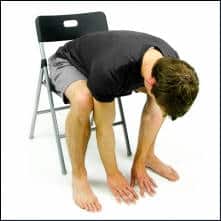
- Sit on a chair with a hard surface
- Place both hands on your knees
- Slide both hands down your legs towards your ankles
- Go down as far as you can
- Hold for 1 second
- Slide back up
- Roll your shoulders 10 times
Vertical Planking
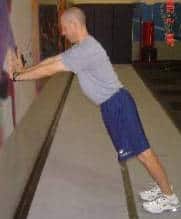
- Stand about 1 to 3 feet away from a wall (like a vertical plank position)
- Lean forward and place both hands on the wall at about chest level
Note: if you are not leaning forward then take a step or two back - Keep your heels on the floor
- Keep your back flat
- Tighten your abdominals and hold for 5 seconds
- Repeat this exercise 10 times
Planking

- Lie on your stomach on a mat (not a mattress or soft surface)
- Lift your body up on your elbows and your knees
- A more advanced level is to be on your elbows and your toes
- Try to keep your back as straight as possible
- Do not allow your hips or pelvis to drop
- Maintain this position for 10 seconds
- Then lower your body down
- Repeat this exercise 3 times
Sit To Stand
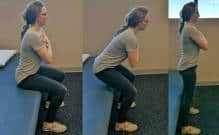
- Sit on a chair with a hard surface and with armrests
- If needed, begin the exercises with 2 hands on each armrest
- Progress to using one hand on one armrest
- You can then further progress to placing both arms folded on your chest
- Tighten your abdominals
- Lean forward slightly and stand up
- Keep your back flat
- Return to sitting position
- Repeat this exercise 10 times
Squatting

This is very similar to the Sit To Stand exercise mentioned above – difference is you will be lowering you body more than just chair height. This is ONLY recommended to perform IF your physical therapist has cleared you.
- Stand with feet apart – about 10 inches apart
- Both arms should be out straight in front of you (like a Zombie)
- I would recommend to have something behind you such as a large bean bag chair or a low ottoman just in case you tip backwards
- Bend both your knees slightly and lean forward from your hips slightly
- Keep your feet flat on the ground at all times
- Stand back up
- You can make the exercise more difficult by squatting lower but you must keep your feet flat at all times
- Repeat this exercise 10 times
Bridging
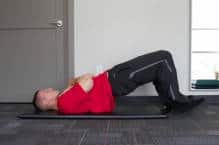
- Lie on your back on a mat (not a mattress or soft surface)
- Bend your knees
- Tighten your abdominals
- Lift your hips up towards the ceiling
- Hold this position for 5 seconds
- Repeat this exercise 10 times
Superman
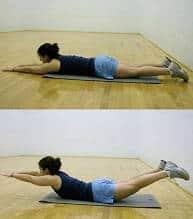
This may be the most difficult to perform for some if you have issues with kyphosis (a hunched back)
- Lie on your stomach on a mat (not a mattress or soft surface)
- If you have kyphosis you can place a pillow or two under your pelvis to help you to lay on your stomach and perform this exercise
- Legs straight and both arms straight in front of you
- Tighten your abdominals
- Lift your arms and your legs off the floor as high as you can without straining
- Hold this position for 5 seconds
- Repeat this exercise 10 times
Seated Oblique Exercises
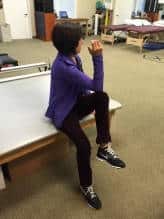
For some this exercise may not be achievable initially but the goal is to continue the exercise until you can – or at least as much as you can.
- Sit on a chair with a hard surface
- Both feet must be flat on the ground
- Tighten your abdominals
- Rotate your torso to the left and then to the right (twist)
- Repeat this again but this time place one hand on the opposite knee and rotate
- Then proceed to the higher level of doing the exercises with lifting the leg to the opposite elbow
- Keep your back straight (no slouching or bending forward)
- Exhale and bring right foot off the floor and towards your left side
- Tap your left elbow to your right knee
- Then bring your right foot back down
- Exhale and bring your left foot off the floor and towards your right side
- Tap your right elbow to your left knee
- Repeat this exercise 5 times with each leg
Seated Leg Raise
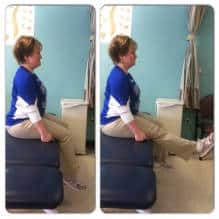
- Sit on a chair with a hard surface and armrests
- Sit all the way back leaning against the back of the chair
- Place both arms on the armrests
- Start with one leg at a time
- Both feet are under the chair with your knees bent
- Tighten your abdominals
- Raise both legs in front of you about 1 foot above the ground
- Hold this position for 2 seconds
- Bring your feet back under the chair
- Repeat this exercise 10 times
Again, we repeat that you should initially perform these exercises with a physical therapist who can no only help you to perform the correctly and safely but could also recommend modifications and/or other exercises to help you build your core.
Why Should Seniors Work On Core Exercises?
There’s no doubt that stronger muscles and better flexibility both contribute to a better aging process. After all, who wants to live with stiffness, pain and limited mobility?
Having a strong core is an essential part of your overall health; without a strong core, you are more at risk for injuries from falls due to poor balance and limited mobility. In fact, every movement you make is generated from your core, which means if your core is weakened, other muscles need to work harder to pick up the slack. This is a key contribution to injuries in seniors. – American Senior Communities
There are 2 main reasons why older adults should include core exercises as part of their daily fitness routine.
- Core exercises improves the overall muscle strength of your core muscles which in turn helps to prevent you from losing your balance and falling and risking injury.
- Stronger core muscles should help you to perform all your daily tasks easier
Conclusion
Finally, I just want to encourage you to start working on your physical body today. I have seen great improvement in my patients who follow their prescribed exercise programs and I would love to hear that you get the same benefits as well.
